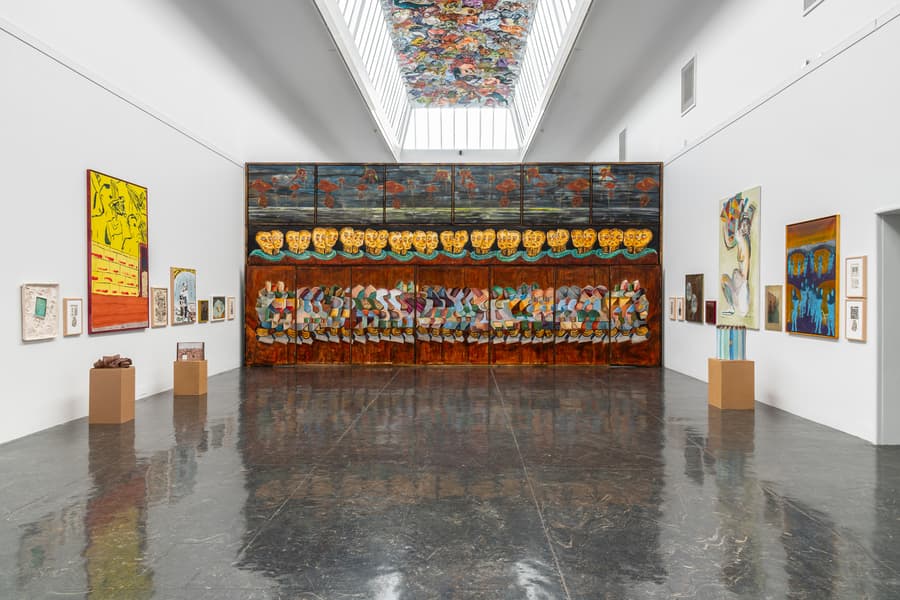Sidsel Bergløff og Anne Marie Komissar
Catalog text
TEXTILE PROJECT 1983
After the creation of the Utsmykkingsfondet for new state buildings in 1977, the image has art has come to stand increasingly in focus as an integrated and positive
The grants for artistic decoration that are currently available through the Foundation, the Norwegian Culture Council and Oslo Municipality to name the most important financial ones, represent major tasks, major challenges for the visual artists and there is reason to believe that the public sector will also in the future have commitment and willingness to assume responsibility for a richer public environmental design. Combined with the intention of making significant Norwegian contemporary art known and accessible to the general public, we believe that this will lead to an increase in the number of decorating tasks.
With this exhibition, the two of us will primarily contribute to broadening the perception of what textile visual art can be in a decorative context. It is our point of view that the attempts that have been carried out so far have largely limited the possibilities for what textile visual art can contribute - and that is, we believe, something far more comprehensive than what the realities show us today, both in terms of form, use of materials and placement in rooms, to mention the most important elements that matter in environmental design.
The aim of what we have chosen to call a project exhibition is to try to demonstrate unproven ways of using textile works and to present a more extended view of what textile decoration can entail. We therefore hope that the relatively few, but still varied proposals for textile environmental design will give builders, architects and others responsible in the context of decoration, more impulses to work from when thinking about textile art. Over the past 15 years, we have both had assignments in the public and private sector, assignments that have brought challenges and given the opportunity for artistic development through the requirements that have been set for adaptation to a given environment. Nevertheless, today we sit with a certain feeling that we are given, or have given ourselves, too narrow a framework, the challenges are limited.
As invited artists to a closed competition for textile decoration for the Realfagbygget in Bergen in 1980, we both experienced the need and necessity to work with alternative forms and versions for textile artistic expressions.
The science building's entrance was to have textile decoration and the dimensions of the task were formidable. With a central wall section of approx. 90 m2, strongly dominated by heavy crossing footbridges, the task represented a challenge that clearly had to involve something different from the previous decoration task that had been required of us.
It was therefore precisely the participation in the competition that indirectly gave the impetus to the idea of a collaboration on an exhibition. We agreed to continue the challenge from Bergen, concretized in the form presented at this exhibition. This collaboration arose without any of us having previous experience with problems of the kind such close collaboration entails. Each of us was used to working independently, whether it was in the context of assignments or with independent tapestries. For both of us, it has of course been a necessary and significant readjustment process. We have gained important and significant experience which we believe, both collectively and individually, will be important within our area of work in the future.
We have found the artistic and technical details that are the consequence of the projects we have chosen to present to be inspiring to solve, both in terms of their magnitude and the particular requirements the material choices have made. From our side, right from the start, there has been a conscious thought behind the presentation of the projects in what we can call non-traditional textile materials, such as paper and sailcloth.
Firstly, it has given us the opportunity to work on more and larger tasks than the full use of textile weaving techniques would allow, both in terms of time and finances. To say a little more about the collaboration, it has meant that we feel more experienced and more aware of what extensive preliminary work has to say for the final result, — giving verbal and pictorial expression of which compositional, decorative elements to be used or discarded has given us an insight that we feel we could not so easily arrive at on our own.
The collaboration has also led to the fact that we can eventually think of drawing in and experimenting further with other materials in our works, than those that are traditionally perceived as plain textiles.
We feel more mature to collaborate with artists from other professional groups in order to be able to think more holistically in the context of decoration.
As artists living in Bærum, we have found it natural for a couple of the projects to start from existing buildings there. The purpose of this is to show concrete proposals within an already given framework that we find architecturally exciting.
The Høvikodden Art Center has, by making work premises available to us in the autumn of 1982 and up until the exhibition, has contributed to a very large extent to the fact that the intentions that we have explained above have also been realized in practice.
In this way, we would especially like to thank the Art Center's management for that.
-Sidsel og Anne Marie


